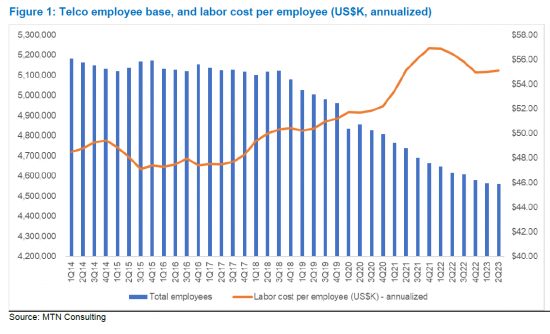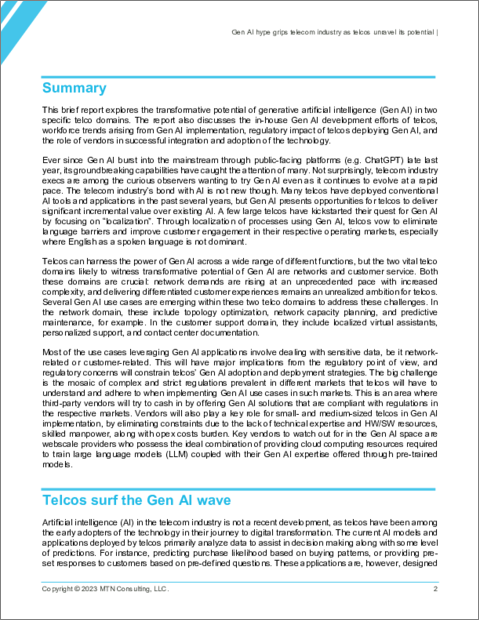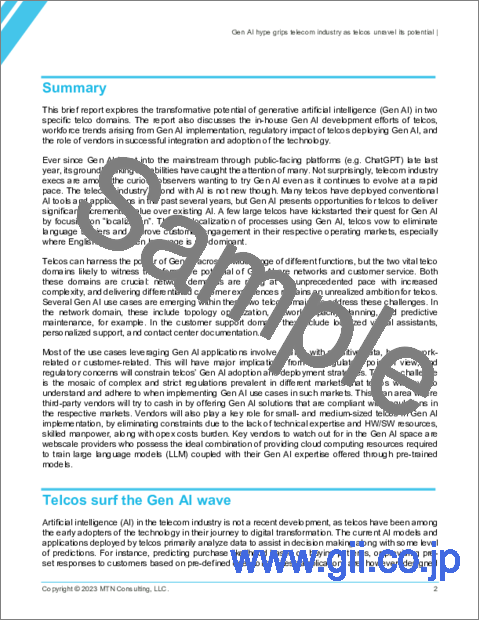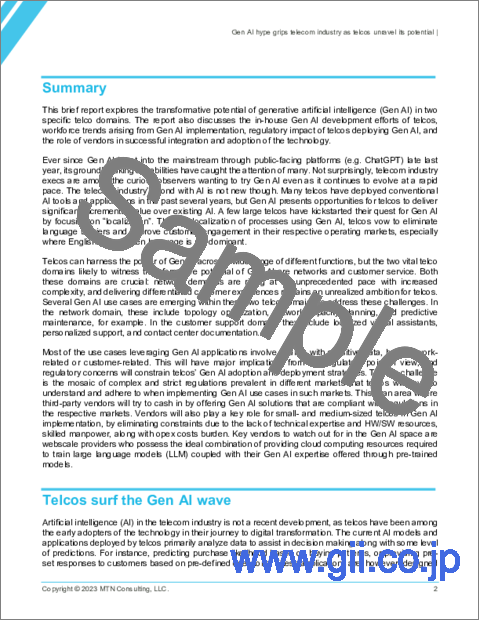|
|
市場調査レポート
商品コード
1388504
生成AIが通信業界を席巻:ネットワーク最適化と差別化された顧客体験は有望な出発点となるも、規制上の不確実性が大きな障害となるGen AI Hype Grips Telecom Industry as Telcos Unravel its Potential: Network Optimization and Differentiated Customer Experience are Promising Starting Points, but Regulatory Uncertainty Will Be a Major Impediment |
||||||
|
|||||||
| 生成AIが通信業界を席巻:ネットワーク最適化と差別化された顧客体験は有望な出発点となるも、規制上の不確実性が大きな障害となる |
|
出版日: 2023年11月24日
発行: MTN Consulting, LLC
ページ情報: 英文 13 Pages
納期: 即納可能
|
- 全表示
- 概要
- 目次
当レポートでは、2種類の電気通信分野での生成AIによる変革の可能性について考察すると共に、通信企業の内部における生成AI開発の取り組みや、生成AIの導入に伴う労働力の動向、通信企業の生成AI導入に伴う規制面での影響、技術の統合・導入を成功させるためのベンダーの役割などについて考察しております。
本文中の図表より

昨年末、生成AIが一般向けプラットフォーム (ChatGPTなど) を通じてメインストリームに登場して以来、その画期的な能力は多くの人々の注目を集めてきました。驚くべきことではないですが、通信業界の幹部は、生成AIが急速なペースで進化し続けているにもかかわらず、生成AIを試してみたいという好奇心旺盛なオブザーバーの一人です。しかし、通信業界とAIの結びつきは新しいものではありません。過去数年間、多くの通信企業が従来型のAIツールやアプリケーションを導入してきたが、生成AIは通信企業が既存のAIを大幅に上回る価値を提供する機会を提供しています。いくつかの大手通信企業は、「ローカリゼーション」に焦点を当てることで、生成AIへの探求を開始しました。生成AIを使用したプロセスのローカライズを通じて、通信企業は、特に話し言葉としての英語が支配的でないそれぞれの営業市場において、言語の障壁を取り除き、顧客エンゲージメントを向上させることを狙っています。
通信企業は、幅広いさまざまな機能で生成AIの力を活用することができますが、生成AIの変革の可能性を目の当たりにする可能性が高い2つの重要な通信事業ドメインは、ネットワークと顧客サービスです。この2つの領域はいずれも極めて重要であり、ネットワークの需要は複雑化とともにかつてないペースで高まっており、差別化された顧客体験を提供することは、通信企業にとって実現不可能な野望のままです。この2つの通信事業領域では、これらの課題に対処するために、生成AIの使用事例がいくつか登場しています。ネットワーク領域では、例えばトポロジー最適化、ネットワーク容量計画、予知保全などが挙げられます。カスタマーサポートの領域では、ローカライズされたバーチャルアシスタント、個別化されたサポート、コンタクトセンターの文書化などが挙げられます。
生成AIアプリケーションを活用する使用事例のほとんどは、ネットワーク関連であれ顧客関連であれ、機密データの取り扱いを伴います。これは規制の観点からも大きな影響を及ぼし、規制上の懸念が通信企業の生成AI導入・展開戦略を制約することになります。大きな課題は、さまざまな市場で普及している複雑で厳しい規制の集合体であり、こうした市場で生成AIのユースケースを導入する場合、通信企業はこれを理解し、遵守しなければなりません。この分野では、サードパーティー・ベンダーが、各市場の規制に準拠した生成AIソリューションを提供することで利益を得ようとしています。ベンダーはまた、中小規模の通信企業が生成AIを導入する際、技術的専門知識やHW/SWリソース、熟練した人材の不足による制約を排除し、OPEXコストの負担を軽減することで、重要な役割を果たすと思われます。生成AI分野で注目すべき主要ベンダーは、大規模言語モデル (LLM) の学習に必要なクラウドコンピューティング・リソースと、事前学習済みモデルを通じて提供される生成AIの専門知識を組み合わせた理想的な組み合わせを提供するWebスケールプロバイダーです。
本文中で言及された企業
|
|
目次
- サマリー
- 生成AIの波に乗る通信企業
- ネットワーク運用と顧客サポートが、主要な変革分野となる
- 生成AI時代には、通信企業の従業員はよりスリムかつスマートになる
- 厳しい規制が、通信企業にとって大きな障壁となる
- 生成AI統合の鍵となるベンダー:Webスケールプロバイダーが通信企業の利益を更に狙う
- ロックインのリスクとソフトウェアコストの上昇:ベンダー選択時の重要な考慮事項
- 付録
This brief report explores the transformative potential of generative artificial intelligence (Gen AI) in two specific telco domains. The report also discusses the in-house Gen AI development efforts of telcos, workforce trends arising from Gen AI implementation, regulatory impact of telcos deploying Gen AI, and the role of vendors in successful integration and adoption of the technology.
VISUALS

Ever since Gen AI burst into the mainstream through public-facing platforms (e.g. ChatGPT) late last year, its groundbreaking capabilities have caught the attention of many. Not surprisingly, telecom industry execs are among the curious observers wanting to try Gen AI even as it continues to evolve at a rapid pace. The telecom industry's bond with AI is not new though. Many telcos have deployed conventional AI tools and applications in the past several years, but Gen AI presents opportunities for telcos to deliver significant incremental value over existing AI. A few large telcos have kickstarted their quest for Gen AI by focusing on "localization". Through localization of processes using Gen AI, telcos vow to eliminate language barriers and improve customer engagement in their respective operating markets, especially where English as a spoken language is not dominant.
Telcos can harness the power of Gen AI across a wide range of different functions, but the two vital telco domains likely to witness transformative potential of Gen AI are networks and customer service. Both these domains are crucial: network demands are rising at an unprecedented pace with increased complexity, and delivering differentiated customer experiences remains an unrealized ambition for telcos. Several Gen AI use cases are emerging within these two telco domains to address these challenges. In the network domain, these include topology optimization, network capacity planning, and predictive maintenance, for example. In the customer support domain, they include localized virtual assistants, personalized support, and contact center documentation.
Most of the use cases leveraging Gen AI applications involve dealing with sensitive data, be it network-related or customer-related. This will have major implications from the regulatory point of view, and regulatory concerns will constrain telcos' Gen AI adoption and deployment strategies. The big challenge is the mosaic of complex and strict regulations prevalent in different markets that telcos will have to understand and adhere to when implementing Gen AI use cases in such markets. This is an area where third-party vendors will try to cash in by offering Gen AI solutions that are compliant with regulations in the respective markets. Vendors will also play a key role for small- and medium-sized telcos in Gen AI implementation, by eliminating constraints due to the lack of technical expertise and HW/SW resources, skilled manpower, along with opex costs burden. Key vendors to watch out for in the Gen AI space are webscale providers who possess the ideal combination of providing cloud computing resources required to train large language models (LLM) coupled with their Gen AI expertise offered through pre-trained models.
Companies Mentioned:
|
|
Table of Contents
- Summary
- Telcos surf the Gen AI wave
- Network operations and customer support will be key transformative areas
- Telco workforce will become leaner but smarter in the Gen AI era
- Strict regulations will be a major barrier for telcos
- Vendors key to Gen AI integration; webscale providers set for more telco gains
- Lock-in risks and rising software costs are key considerations in choosing vendors
- Appendix
Figures:
- Figure 1: Telco employee base, and labor cost per employee (US$K, annualized)
Tables:
- Table 1: Self-developed Gen AI-based tools of select telcos
- Table 2: Gen AI-based tools of select telco vendors






